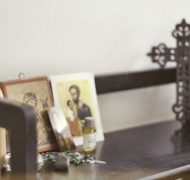Spiritual Field Trip #1
Blog / Produced by The High Calling
Last week I wrote about my wife and I making plans to take our children on a series of spiritual field trips to worship with other traditions. We’re very excited about our little project. Sunday was our first field trip, and we headed for Saint Sophia, a Greek Orthodox Church here in San Antonio.
On the way to worship I tried to give the girls a quick overview of Orthodox history and theology. Taking cues from their facial expressions, it was a very hasty lesson, made up of a few simple bullet points:
- Separated from the Roman Catholic Church about 1000 years ago because of the filioque.
- Don't worry about what filioque means. You wouldn't care anyway.
- Have very formal and LONG services.
- Will probably not understand much of what we hear, but it will be beautiful.
- Don’t be surprised if much of the service is, in fact, in Greek.
Orthodox worship can be culturally shocking to teen-agers who have spent their lives in the evangelical tradition. The 45 page Divine Liturgy used at Saint Sophia would be hard for newcomers to follow even if half of it wasn't in Greek. But there were parts that attracted the girls’ attention. There was an important moment when the priest emerged from the iconostas with a gleaming, silver covered Bible and announced like a medieval herald that all should attend because holy scripture was to be read. The many candles, the heavy scent of incense puffing out of censers, the dark wood, and the Orthodox art gave the room a majestic feel.
At one point in the service, the priest came down the left aisle of the church with a contingency of robed boys, carrying the elements of communion, the body and blood of Christ. The congregation turned to face the elements as the priest crossed the back of the church and went back up the center aisle. Many worshippers turned 360 degrees in their pews to respectfully keep their faces toward the sacred elements. We followed their lead and turned respectfully in our pews as well, honored to be part of the worshipping body of Christ on this day.
When it was over we went out for lunch at Jim’s, a famous diner here in our city. We enjoyed eggs and french toast while talking about what we had seen. The girls, understandably, had some questions. They wondered about the use of incense in worship. I didn’t have a good answer for them, but we noted that using incense meant all five of our senses were involved in worship. You see and hear the singing. You touch and embrace other worshippers. You smell the incense. And you taste the elements of communion. My middle daughter said, “I think it’s cool that your church would have a distinct smell, you know?” We also all agreed that the deep reverence the community at Saint Sophia held for communion was a powerful witness to this sacred Christian ritual. And we wondered if perhaps we evangelicals don’t offer and receive communion a little too casually at times.
But the most interesting discussion had to do with how hard Orthodox worship is for visitors to understand and follow. Many evangelical churches pride themselves on being easy to understand and “relevant,” whatever that means. I asked the girls how user-friendly they thought a church should be. We couldn't come up with an easy answer for that question. We felt that it is good for visitors to understand what is going on in worship, but if you change your worship style every ten years to keep up with the fickle tastes of our culture, you run the risk of losing theological depth. I thought it was a good Sunday. The girls were interested and engaged. We had a meaningful time of worship that stretched us spiritually and physically. And the conversation after was lively. I think this is a good start.
Gordon Atkinson
I think our next visit will be to the most user-friendly church we can find - a mega-church with contemporary worship music, video screens, and easily understood theology.




